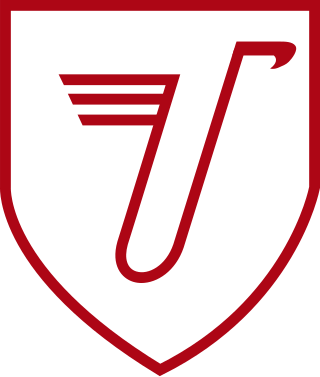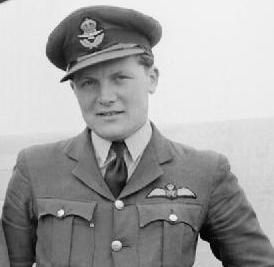
During World War I and World War II, Switzerland maintained armed neutrality, and was not invaded by its neighbors, in part because of its topography, much of which is mountainous. Germany was a threat and Switzerland built a powerful defense. It served as a "protecting power" for the belligerents of both sides, with a special role in helping prisoners of war. The belligerent states made it the scene for diplomacy, espionage, and commerce, as well as being a safe haven for 300,000 refugees.

The escort fighter was a concept for a fighter aircraft designed to escort bombers to and from their targets. An escort fighter needed range long enough to reach the target, loiter over it for the duration of the raid to defend the bombers, and return.

Operation Flax was an Allied air operation during the Tunisian campaign, as part of the larger North African campaign of the Second World War. Flax was intended to prevent air supply between Italy and the Axis armies in Tunis, Tunisia, in April 1943. An equivalent Allied naval effort was called Operation Retribution.

Jagdgeschwader 3 "Udet" was a Luftwaffe fighter wing of World War II. The Geschwader operated on all the German fronts in the European Theatre of World War II. It was named after Ernst Udet, an important figure in the development of the Luftwaffe, in 1942.

Jagdgeschwader 11 was a fighter wing of the German Luftwaffe during World War II. Its primary role was the defense of Northern Germany against Allied day bomber raids. Formed in April 1943 as a split from Jagdgeschwader 1, the unit primarily used the Messerschmitt Bf 109 and Focke-Wulf Fw 190.

The Air Force of the Independent State of Croatia, was the air force of the Independent State of Croatia (NDH), a puppet state established with the support of the Axis Powers on the territory of the Kingdom of Yugoslavia during World War II. The ZNDH was founded under German authority in April 1941, following the German-led Axis invasion of Yugoslavia.

The Defence of the Reich is the name given to the strategic defensive aerial campaign fought by the Luftwaffe of Nazi Germany over German-occupied Europe and Germany during World War II. Its aim was to prevent the destruction of German civilians, military and civil industries by the Western Allies. The day and night air battles over Germany during the war involved thousands of aircraft, units and aerial engagements to counter the Allied strategic bombing campaign. The campaign was one of the longest in the history of aerial warfare and with the Battle of the Atlantic and the Allied Blockade of Germany was the longest of the war. The Luftwaffe fighter force defended the airspace of German-occupied territory against attack, first by RAF Bomber Command and then against the United States Army Air Forces (USAAF) in the Combined Bomber Offensive.
The history of the Swiss Air Force began in 1914 with the establishment of an ad hoc force consisting of a handful of men in outdated and largely civilian aircraft. It was only in the 1930s that an effective air force was established at great cost, capable of inflicting several embarrassing defeats on the Nazi Luftwaffe in the course of an initially vigorous defence of neutral Swiss airspace. The Swiss Air Force as an autonomous military service was created in October 1936. After World War II it was renamed the Swiss Air Force and Anti-Aircraft Command and in 1996 became a separate service independent from the Army, under its present name Schweizer Luftwaffe.
Zerstörergeschwader 76 was a Zerstörergeschwader (wing) of the German Luftwaffe during World War II. The wing operated the Messerschmitt Bf 109 in the early phases of World War II, then the Messerschmitt Bf 110 for the duration of the war.

Zerstörergeschwader 26 "Horst Wessel" was a Luftwaffe heavy fighter wing of World War II.
I. Jagdkorps was formed 15 September 1943 in Zeist from the XII. Fliegerkorps and the Luftwaffenbefehlshaber Mitte, and later subordinated to the Luftflotte Reich. The Stab relocated to Brunswick-Querum in March 1944 and to Treuenbrietzen in October 1944. The unit was disbanded on 26 January 1945 and its obligations were taken over by IX.(J) Fliegerkorps.

Flyer Command Iraq was a unit of the German Air Force (Luftwaffe) sent to Iraq in May 1941 as part of a German mission to support the regime of Rashid Ali during the Anglo-Iraqi War. The mission was part of a larger effort to gain support in the Middle East for the Axis Powers against the United Kingdom and its allies during World War II.

The Battle of the Heligoland Bight was the first "named" air battle of the Second World War, which began the longest air campaign of the war on 3 September 1939, the Defence of the Reich. After the declaration of war, RAF Bomber Command began operations against Nazi Germany but limited their attacks to those targets that were purely military and had little risk of civilian casualties. This largely limited their efforts to attacks on the Kriegsmarine warships in German ports to prevent their use in the Battle of the Atlantic.
The Messerschmitt Bf 109 was a German World War II fighter aircraft designed by Willy Messerschmitt and Robert Lusser during the early to mid-1930s. It was one of the first true modern fighters of the era, including such features as all-metal monocoque construction, a closed canopy, a retractable landing gear, and was powered by a liquid-cooled, inverted-V12 aero engine.
Sint-Truiden / Brustem Airfield is an airfield located in Brustem, 1.5 nautical miles southeast of Sint-Truiden (Limburg) and approximately 37 mi (60 km) east of Brussels. Formerly known as Sint-Truiden Air Base or Brustem Air Base, the aerodrome was deactivated as a Belgian Air Component base in 1996.

Zerstörergeschwader 1 was a Luftwaffe zerstörer or ‘destroyer’ wing of World War II.

The Messerschmitt Bf 110, often (erroneously) called Me 110, was a twin-engine heavy fighter in the service of the Luftwaffe during World War II. Hermann Göring was a proponent of the Bf 110, and nicknamed it his Eisenseiten ("Ironsides"). Development work on an improved type to replace the Bf 110, the Messerschmitt Me 210 began before the war started, but its teething troubles resulted in the Bf 110 soldiering on until the end of the war in various roles, alongside its replacements, the Me 210 and the Me 410.
Fighter-bomber attacks on the United Kingdom during World War II were conducted by the German Luftwaffe during the Second World War.
Zerstörergeschwader 2 was a Luftwaffe heavy/destroyer Fighter Aircraft-wing of World War II.

Newell Orton, was a British flying ace of the Royal Air Force (RAF) during the Second World War. He was officially credited with the destruction of 17 enemy aircraft.















